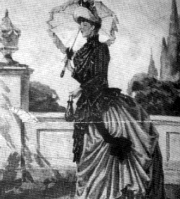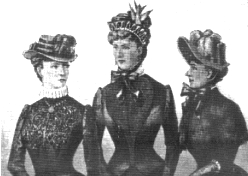Women's Fashion in early Johannesburg (1800's - 1900's) Page 1

Johannesburg grew rapidly after the discovery of gold; it was a dramatic and continual growth which is still going on.In 1886 houses were built of wood and corrugated iron, often transported in sections by ox-wagon all the way from Pietermaritzburg. Many of these easily assembled homes soon covered the flat plain on which the city arose.
The wagoners who transported the goods from Volksrust, the nearest staging post to the railway terminus at Charlestown on the Natal/Transvaal border, were mainly Afrikaans-speaking. They became a settled and integral part of the Johannes- burg community and built for themselves neat little cottages in Braamfontein, Newlands, and Vrededorp.
The thousands of new arrivals who were drawn to the gold diggings came here from five different continents and spoke a host of different languages, but the overwhelming majority had one thing in common - they were nearly all young bachelors. Con- sequently it is not easy to determine what sort of clothes women in Johannesburg wore for women were so rare in 1886.
Contemporary photographs are unanimous in bearing witness to the fact that a female in the mining camp was so rare as to inspire comment. Photographs in the possession of members of pioneer Afrikaans-speaking families on the Witwatersrand do, however, give a very clear inidication of what the average Republican Miss wore in the year that the gold town was first proclaimed.
As in any other year of the 19th century the young lady of 1886 was covered from top to toe. A fitted, boned bodice always made separately from the skirt and worn over the tightly-laced corset was often made by the Afrikaans-speaking housewife who had been trained to sew and make her own clothes from her earliest years.


Images. Fashion in the late 1800's. Right: Adomments on women's head-dress often included one or two stuffed birds or a few ostrich plumes.
The bustle, really a crinolette, returned to fashion after a short hibernation during the year 1884 when gold was first dicovered in payable quantities in the South African Republic. The bustle consisted of one, two or three wire-braided pads worn at the back and suspended by a belt worn around the waist. This was covered by a foundation skirt which was superimposed by a shorter overskirt or draperies caught up in the back. Jersey-cloth was the material most often used for the bodice as well as the foundation skirt.
As the years marched on and the wood-and-iron houses gave way to concrete structures the presence of more women in the Uitlander population became evident. Single men who had journeyed by wagon to Rand later brought wives from the coastal cities to Johannesburg, and these woman more often than not wore what was the latest trend in England - namely the tailored suit comprising coat, skirt, and shirt-blouse. Tightly-fitted jackets were known as paletots.